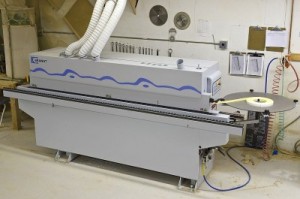 The edgebander is one of those machines that shop owners simultaneously praise and despise. Manually edgebanding parts is miserable, but the dozens of intricate parts that have to work in perfect unity inside an edgebander ensures that the possibility of a breakdown is always right around the corner…at least that’s the impression I gathered after months of research.
The edgebander is one of those machines that shop owners simultaneously praise and despise. Manually edgebanding parts is miserable, but the dozens of intricate parts that have to work in perfect unity inside an edgebander ensures that the possibility of a breakdown is always right around the corner…at least that’s the impression I gathered after months of research.
Before we purchased an edgebander of our own, we would pay to use one at a nearby shop. Mark, the shop owner, was a great guy, and he made the edgebanding process as easy as it could be. This set-up worked well for a few years, but recently both of us have become very busy, and the process of having to schedule our edgebanding needs around the workflow of another shop was getting to be a real drag. Also, as our workload increased, the process of loading cabinet parts, driving to the shop, unloading those parts, and then repeat that process to get back to our shop, quickly became a massive bottleneck in our production.
An edgebander was on my radar for about a year before we finally acquired the Brandt Ambition. Early in 2012 I was working with Coby, at Advanced Machinery Systems, to try and find a used edgebander, in good shape, at a reasonable price.
My only criteria was that the edgebander be reliable. I wanted to be able to turn the machine on, send parts through, and move on to the next step, without having to worry everyday whether the machine would do its job. Unfortunately, after a few months, we found the pickings pretty slim. The only edgebanders in my initial price range were 8-10 years old and Coby felt like at that age, reliability was not going to be their strongest trait, and I could possibly be saddled with a machine that was a maintenance nightmare. After one last scouring of the used market, I turned my search towards new machines.
 Coby’s company sells and his technicians service Brandt edgebanders, and the newly released Ambition line of edgebanders were specifically designed as an entry-level edgebander for the small shop. The base-level machine comes with front and end trim, top and bottom trim, and a buffing station. A pre-mill station, which mimics a jointer by prepping the panel’s edge, can be added, as can a scraping station.
Coby’s company sells and his technicians service Brandt edgebanders, and the newly released Ambition line of edgebanders were specifically designed as an entry-level edgebander for the small shop. The base-level machine comes with front and end trim, top and bottom trim, and a buffing station. A pre-mill station, which mimics a jointer by prepping the panel’s edge, can be added, as can a scraping station.
After looking over all the options, contemplating what edgebanding requirements we needed and what our budget would allow, we decided on the base model of the Ambition, complete with the trimming stations and the buffing wheels. The pre-mill station would have been a real luxury, but one I felt was not worth another $7K. We also skipped adding the scraping stations, since we don’t do any 3mil edgebanding. In the future, if we need to have that capability, we can add that station into the machine.
While in Atlanta at IWF 2012, I met Coby at the Stiles booth and took the Ambition for a test run. With all the settings dialed in, the results were perfect. The main thing I wanted to see was how easy it would be to switch from .5 mil vinyl edgeband to 1.5 mil solid wood edgeband, which are the only two edgeband products we currently use. The answer was, pretty simple. Adjust the pressure roller wheel and the top and bottom trim routers and you are ready to go. I was quite impressed and my worries about having an edgebander, and the headaches that come along with them, were fading away.
Find out more about how this edgebander fits into my shop and my opinion on it after four months of use next week.






Have something to say? Share your thoughts with us in the comments below.